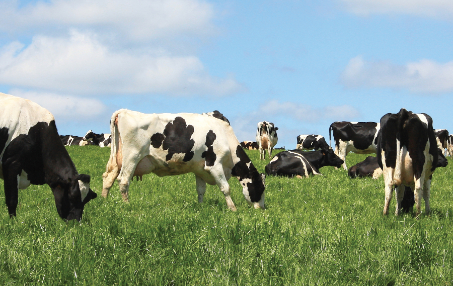Technical Herd Management in the Modern Day

By Jaclyn Krymowski.
For quite some time now, dairy herd management has been digitalized either partially or fully on most farms. But just like our smartphones, software and other forms of recordkeeping, digitalization continues to evolve. Simple updates, newer versions and straight up new competition in the marketplace keep us on our toes.
The more strategies and tools that are developed to track data and interpret results, the more decisions there are to make regarding what technology to use.
Today’s Marketplace
Today, dairy producers can use long-time classics along with new options developed by both seasoned industry companies and some new players.
There are several different applications that provide a perfect example of the data output from on-farm software, including CowManager, BoviSync, and Afimilk. Some applications can also be integrated into DairyComp or PCDart. Physical systems like pedometers, electronic collars, robotic milking units, and, quite recently, camera vision can be integrated to track health and performance.
While DairyComp and PCDart are great applications that have helped track and record information, making data more integrated minimizes input error and allows for more realtime and fluent data.
The Netherlands company CowManager, for instance, uses ear sensors that provide information on fertility, health, and nutritional status.
This tracking system easily enables a farmer to check on the herd no matter its size. Additionally, the information is available anytime as an app for the phone, the farm computer or even a tablet.
It also has a multi-view functionality that allows a herdsperson, veterinarian, nutritionist, or other associate to gain remote access to selected data as well.
Available data not only allows the manager or herdsman to check in. It can also keep the nutritionist and veterinarian in the loop so they can assist where needed.
Wisconsin-based BoviSync allows producers to streamline processes on the farm and obtain data that can glean useful insights.
The wonderful part of integrating some sort of software systems like these is that they can save time and labor and other valuable resources.
AfiFarm, like CowManager and Bovisync, is a management tool that helps with data collection and animal monitoring.
Any of these programs are viable options depending on your herd, goals and data desired. Only you can determine which option best serves your purpose.
A robotic milking system can also be an option to obtain a good portion of milking parlor data, and, in some applications, feed data. Regarding 24/7 software, equipment attached to the cow or a camera system over the pen is the most useful for tracking more than just milk stats.
Benefits of Management Software
Comprehensive data analysis is crucial for effective herd management. The major challenge is to extract profitable insights from the abundance of available information so informed decisions can be made. A robust herd management system goes beyond collecting extensive data on milk production. It also incorporates the ability to combine and interpret this information at key junctures.
“Dairy management software is a crucial tool for the efficient and effective management of dairy businesses. It offers a wide range of features and functionalities that streamline various aspects of dairy operations,” Milk Delivery Solutions shares in their Medium article, Dairy Management Software: Streamlining Operations and Enhancing Profitability in the Dairy Industry.
Having the ability to automate and simplify tasks is one of the many benefits of a dairy management software. Software can help a producer monitor milk production and track health and performance to make effective, efficient plans.
Along with operational management, the data generated in reports also enables the farmer to make educated decisions to improve and optimize the overall operation.
Being able to share data and communicate with objective information makes upgrading and improving the operation a worthwhile investment. However, it is important to utilize and correctly interpret data to ensure it is used correctly.
“Another important aspect of dairy management software is its inventory and financial management capabilities,” Milk Delivery Solutions writes. “It helps in tracking milk inventory, managing expenses, and generating invoices. This ensures accurate record-keeping and financial transparency, enabling dairy businesses to maintain profitability and comply with regulatory requirements.”
Keeping the Dairy up to Date
It can be a BIG jump to implement new software onto the farm, even if you are just including a new add-on to an existing platform. But that shouldn’t intimidate you away from trying new things.
Take a gradual approach and don’t take everything at face value as you become familiar with something new. Your reps are good resources, but you should also explore independent sources such as other farmers who are already using them.
When you enlist the help of a rep, be sure to ask relevant questions up front. A growing concern and gray area is data ownership. Digital data is valuable, and not only to your farm. Be sure to read your contracts thoroughly and fully understand who owns the data and has access to it.
And of course, always evaluate the cost of upgrading to a system. What is the benefit in the long run? What is the profit gain from being able to have 24/7 data?
In most cases, the benefits outweigh the cost of not taking the leap. The data obtained can help a producer fine tune the day-to-day operations. This has potential to not only save money, but also make improvements (if applied correctly) where there is a profit gain.
Implementing a herd management system often enhances the farm and takes it to the next level.
The integration of herd management systems empowers decision-makers to achieve quicker and more precise decisions. Dairy management software emerges as a critical facilitator in streamlining operations, boosting productivity, and augmenting profitability within the dairy sector. Through the strategic utilization of technology, dairy farmers can efficiently optimize their processes, ensuring informed decision-making and maintaining competitiveness in the dynamic landscape of the dairy industry.

